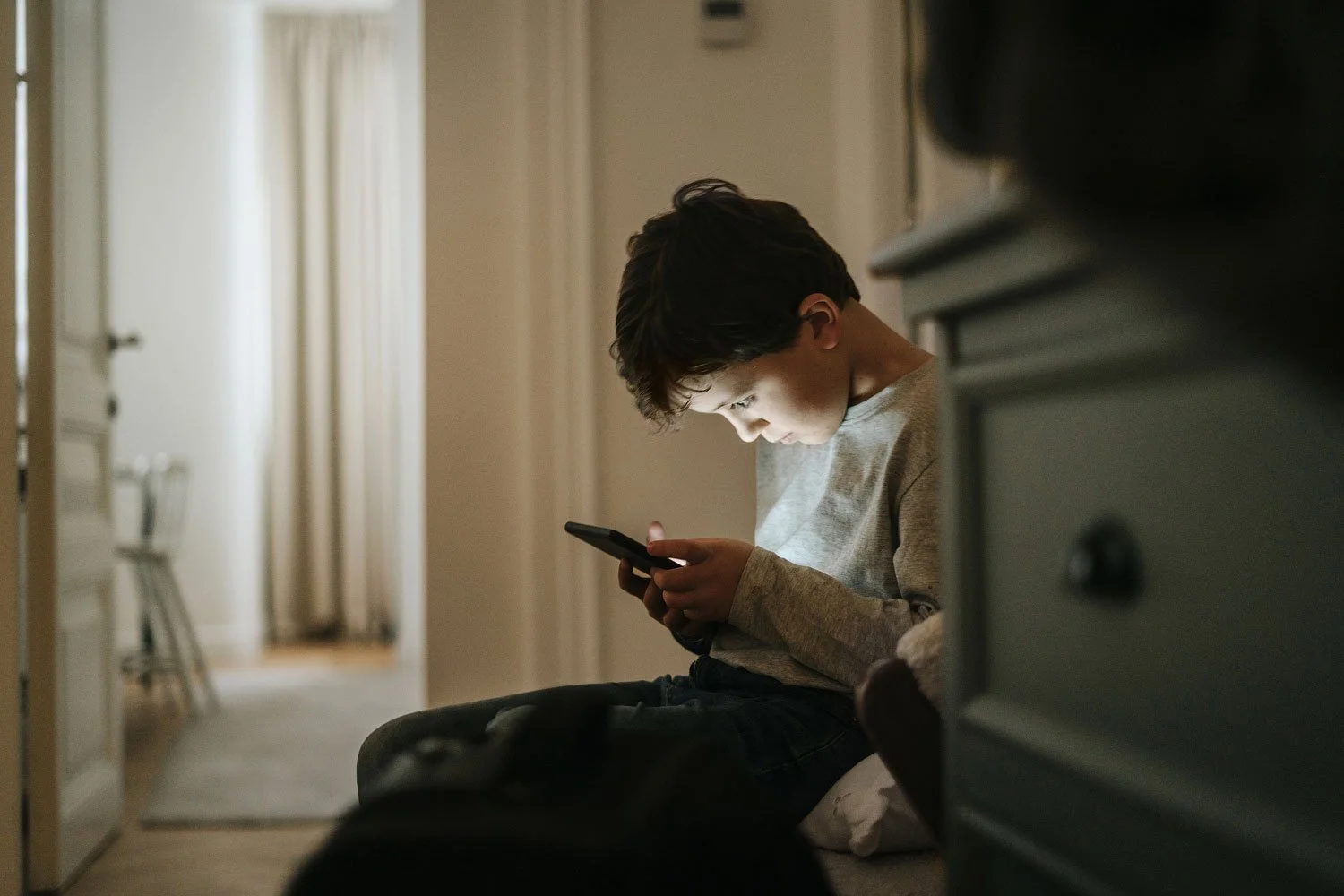How much screen time should your kid have? Plus, 8 tips to help

Clinically reviewed by Dr. Chris Mosunic, PhD, RD, MBA
Struggling to manage screen time for your kids? Find out what’s recommended by experts and get 8 tips for setting limits that stick (without the daily battles).
Most parents are juggling a million tasks at once, and when you need to make dinner, respond to an email, or just take five minutes for yourself, there’s an obvious way to keep your kids occupied: putting on their favorite show or movie. And these days, screens—phones, tablets, computers, and TVs—seem to be more readily available than ever.
But how much screen time is too much?
The truth is, not all screen time is created equal, and nobody has it all figured out. What matters is being intentional. This can mean balancing structure with flexibility, setting reasonable boundaries, and most of all, cutting yourself (and your kids) a little slack.
Here are some tips to help you figure out what healthy screen use looks like for your family — and what to do if you want to change how you’re currently operating.
Is screen time bad for kids?
Contrary to what you may have heard, screen time for kids isn’t inherently harmful. In fact, some screen-based activities can be beneficial, like playing educational games or video chatting with family.
The real concern comes down to how much time they’re spending in front of a screen, what kind of content they're consuming, and what it might be replacing.
When screen time takes precedence over sleep, movement, face-to-face interaction, or imaginative play, you may begin to notice some issues. And the problem isn’t just what kids are doing on screens — it’s also how screens might be shaping their brains, bodies, and the way they see the world.
5 potential effects of screen time on children
Here are some of the most common effects experts have identified when it comes to excessive or poorly managed screen time:
1. Sleep disruption: Bright light from screens can interfere with melatonin production, which can make it harder for kids to fall asleep and stay asleep. Overstimulation, especially from fast-paced videos or games, can also wind up their nervous systems at the exact moment their bodies need to rest.
2. Decreased physical activity: Screen time typically replaces time that could be spent running, climbing, or even just doing things like wandering around the house. Movement is critical for healthy brain development and emotional regulation.
3. Behavioral challenges: When screen time becomes the go-to for boredom, frustration, or big feelings, kids can start relying on it to self-soothe. This can make it harder for them to build emotional resilience.
4. Social and emotional delays: Real-life social skills, like reading facial expressions and waiting your turn, are built through face-to-face interaction. Too much solo screen time can leave fewer opportunities to develop those skills.
5. Difficulty with attention and focus: The fast cuts, flashy colors, and constant reward cycles associated with many kids’ videos can train their brains to expect instant gratification. This can make slower tasks, like reading and classroom work, feel more difficult and less interesting.
How much screen time is too much for kids?
There isn't a universal rule for how much screen time is too much. It really depends on your kid and your schedule. That said, the American Academy of Pediatrics (AAP) offers these guidelines as a helpful starting point:
Under 18 months: Avoid screen time completely, except for video chatting with family and friends. At this age, real-world sensory experiences are what help your babies’ brains grow.
18 to 24 months: You can introduce high-quality programming, but it should be co-viewed with a caregiver who can also help make sense of what’s happening onscreen.
2 to 5 years: Limit screen use to about 1 hour per day of high-quality content. Co-viewing is still ideal, so you can help your kid connect the dots between what they see and what they know.
6 years and older: Set consistent limits that prioritize sleep, physical activity, social time, and unstructured play.
The truth is, most families don’t follow these guidelines to the letter, and that’s okay. These are not moral benchmarks. They’re research-backed suggestions meant to help your child’s development.
When it comes to screen time, if your child is sleeping well, moving their body, and maintaining relationships, then you’ve most likely struck a healthy balance. On the flip side, if those core needs are falling through the cracks, maybe it’s time to reevaluate.
How to reduce screen time for kids: 8 tips for setting boundaries
Sometimes setting limits on screen use can feel impossible, especially when you’re tired and they’re melting down. But boundaries around screen use don’t have to be harsh or rigid to be effective.
Here are nine practical, research-backed tips that can help your family develop a healthier relationship with screens, without the daily power struggle.
1. Start with a conversation with them
Many kids cooperate more readily when they understand why a rule exists. Instead of setting new limits around screen time out of the blue, explain your thinking to them.
Consider saying something like, “Hey, I’ve noticed screens are taking up a lot of our time lately. I want to make sure we still have room for playing and connecting. Can we come up with a plan together?” Having a talk like this can shift the energy from control to collaboration.
Read more: 101 fun questions to ask your kid to strengthen your bond
2. Use routines they understand
Cut down on screen time battles by creating routines your kids understand. You might decide there are no screens before school, but then after school, they can have up to 30 minutes after they finish their homework. On the weekend, you could say that devices go off at 7pm.
3. Create screen-free zones
Physical boundaries help create mental ones. Designate certain areas of your home, such as bedrooms and the dinner table, as screen-free. This way, you can protect their sleep and encourage real conversation, respectively.
4. Offer them compelling alternatives
Saying no to screen time is more effective when you’re saying yes to something else.
You might build a menu of screen-free go-tos that your child actually enjoys. You could craft bins of sensory play for younger kids or have board games at the ready for older ones. You could also have a music playlist cued up on your phone, so you can all dance it out at a moment’s notice.
Read more: 60 mindful summer activities for kids that spark joy and wonder
5. Set a timer when they’re using the device
Timers can take the pressure off you being the screen police. Try using visual timers for younger kids, or set a standard kitchen timer for older ones. When the timer goes off, screen time ends.
You could also say, “You get 30 minutes to play, and when the timer beeps, it’s time to switch to something else.” Just be sure to stay consistent. The more predictable the transition, the less drama it creates over time.
6. Model mindful screen habits for them
If you’re glued to your phone or bingeing shows during downtime, your kid is likely taking notes. Practice what you preach. Be mindful about how much time you spend on your phone and narrate your screen-free choices like, “I’m taking a break from my phone to rest my eyes.”
💙 The Tame Your Scrolling Habit series with Rose Nisker can help you create a healthier relationship with your phone.
7. Use content to connect with them
When possible, co-view or co-play with your child. Also, ask questions and stay curious about what they’re into. This can help them process content more thoughtfully.
Watching an episode of their favorite show and talking about what happened is a good way to bond with them over content. You could also try a game they love and let them teach you how to play it.
Here are seven tips for you and your child to learn something new every day and stay curious.
8. Expect setbacks, because no one is perfect
Don’t aim for perfection. Instead, focus on progress. What matters most is consistency and the willingness to keep adjusting based on what’s actually working.
And if you ever find yourself overwhelmed and handing them the tablet, go easy on yourself. You’re allowed to make survival choices. One off day isn’t going to undo all of your previous intentions.
💙 Relieve some of your overwhelm by listening to this meditation from the Ease Parenting Stress series with Jeff Warren.
Screen time for kids FAQs
Should parents limit screen time for kids?
Kids need a balanced mix of stimulation, rest, play, movement, and connection, and setting screen time limits helps maintain that balance.
If it helps, think of limits not as a punishment, but as scaffolding that helps support a healthier relationship with technology.
How much screen time is okay for a child?
Some expert guidelines suggest limiting screen time for young children to an hour per day of high-quality content. Still, older kids and teens will likely have more screen exposure, especially for school and socializing.
To help figure out what’s best for you and your child, look at the big picture. Is your child sleeping well? Are they physically active? Are they generally emotionally regulated and socially connected? If the answers are mostly yes, their screen use is probably okay.
Is educational screen time better than games?
Some educational content helps kids develop language, math, problem-solving, or even emotional skills, but not everything labeled “educational” is effective. Similarly, some games can be creative, collaborative, or strategic, while others are more about endless stimulation.
Instead of relying just on labels, ask yourself if the screen time is enriching and if your child seems engaged. Those questions matter more than the category itself.
What are signs my child has too much screen time?
If you’re not sure if your child has too much screen time, here are some signs to watch out for:
They’re typically irritable after screen time.
They throw intense tantrums when it’s time to turn off a device.
They’re overly fixated on screens at the expense of other interests.
They struggle with sleep, focus, or face-to-face interaction.
Any tips to reduce screen time without a meltdown?
A good way to reduce the chances of a meltdown is to build in transitions. Kids typically resist abrupt changes, so try giving a five-minute warning before screen time ends. You could also use a timer to create external structure, or offer something enticing as the next activity.
Also, avoid using screens as a reward or punishment, as this can create power struggles. But most importantly, validate your child’s feelings. You could say something like, “I know it’s hard to turn this off and you really enjoy it, but we’re done for today. I’m here to help if you’re upset.”
Calm your mind. Change your life.
Mental health is hard. Getting support doesn't have to be. The Calm app puts the tools to feel better in your back pocket, with personalized content to manage stress and anxiety, get better sleep, and feel more present in your life.







